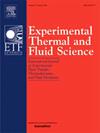Experimental study of flow characteristics on the Ahmed body covered by bio-inspired Convergent–Divergent riblets
IF 3.3
2区 工程技术
Q2 ENGINEERING, MECHANICAL
Experimental Thermal and Fluid Science
Pub Date : 2025-08-23
DOI:10.1016/j.expthermflusci.2025.111595
引用次数: 0
Abstract
The Ahmed body, which features a slanted rear surface, is a generic, simplified representation of ground vehicles. The present work aims to study the flow characteristics around the Ahmed body (with a 35° degree slanted surface) with a roof covered with novel bio-inspired convergent–divergent (C–D) riblets. For this purpose, various experimental measurements have been conducted using Particle Image Velocimetry (PIV) and Hot-Wire anemometry techniques. The findings of PIV measurements on the upper surface of the Ahmed body revealed a delay in detachment near the leading edge and suppression of the low-velocity recirculation region under the effect of C–D riblets, while also showing a reduction in the peak values of the time-averaged contours of Turbulent Kinetic Energy (TKE) and Reynolds shear stress in this region. In addition, the evaluation of the flow field on the slanted surface and in the wake region showed that the upper recirculation bubble behind the Ahmed body coated with C–D riblets moved vertically down (about 6.85%) and shifted upstream (about 22.7%) in the streamwise direction, while the lower recirculation bubble became thinner and more compact. The peak negative and positive values of Reynolds Shear Stress in the upper and lower shear layers behind the Ahmed body decreased with C–D riblets. Power spectrum analysis revealed that the dominant shedding frequency in the lower recirculation region increases (from to 0.245) with the introduction of C–D riblets. Moreover, the Proper Orthogonal Decomposition analysis on the flow field over the roof and in the wake zone showed that the energy levels of the first two modes decreased when C–D riblets were applied.
仿生聚散纹覆盖艾哈迈德体流动特性的实验研究
艾哈迈德车身,其特点是一个倾斜的后表面,是一个通用的,简化的地面车辆的代表。目前的工作旨在研究艾哈迈德体(35°斜面)周围的流动特性,该体的屋顶覆盖着新型的仿生会聚-发散(C-D)纹。为此,使用粒子图像测速(PIV)和热线测速技术进行了各种实验测量。在Ahmed体上表面的PIV测量结果显示,在C-D纹波的作用下,前缘附近的分离延迟,低速再循环区域受到抑制,同时该区域的湍流动能(TKE)和雷诺兹剪切应力的时间平均轮廓值峰值也有所降低。此外,对斜面和尾迹区域流场的评价表明,覆盖C-D纹波的Ahmed体后上部再循环气泡沿流方向垂直向下移动(约6.85%),向上游移动(约22.7%),而下部再循环气泡变得更薄、更致密。随着C-D纹层的增加,艾哈迈德体后上、下剪切层的雷诺剪应力峰值负、正值逐渐减小。功率谱分析表明,随着C-D条纹的引入,低循环区的主导脱落频率从St=0.23增加到0.245。此外,对顶板和尾迹区的流场进行正交分解分析表明,施加C-D纹线后,前两种模态的能级有所降低。
本文章由计算机程序翻译,如有差异,请以英文原文为准。
求助全文
约1分钟内获得全文
求助全文
来源期刊

Experimental Thermal and Fluid Science
工程技术-工程:机械
CiteScore
6.70
自引率
3.10%
发文量
159
审稿时长
34 days
期刊介绍:
Experimental Thermal and Fluid Science provides a forum for research emphasizing experimental work that enhances fundamental understanding of heat transfer, thermodynamics, and fluid mechanics. In addition to the principal areas of research, the journal covers research results in related fields, including combined heat and mass transfer, flows with phase transition, micro- and nano-scale systems, multiphase flow, combustion, radiative transfer, porous media, cryogenics, turbulence, and novel experimental techniques.
 求助内容:
求助内容: 应助结果提醒方式:
应助结果提醒方式:


